Which president, VP tandems won where
In the last four elections for president and vice president, the winning pair did not come from the same ticket in all but one case.
In the 2004 polls, Gloria Macapagal-Arroyo and her running mate Noli de Castro were proclaimed president and vice president.
But in the 1992, 1998 and 2010 elections, the winning president and vice president belonged to different tickets.
The victory of President-elect Rodrigo Duterte and Vice President-elect Leni Robredo in the May polls follows that trend. Duterte was the standard-bearer of PDP Laban while Robredo belongs to the administration Liberal Party.
Out of the 81 provinces in the country, the voters in 51 provinces gave the most number of votes to presidential and vice presidential candidates from different tickets.
Same-ticket voting for president and vice president prevailed in the remaining 30 provinces. This means that the presidential and vice presidential candidates who gained the highest number of votes in these provinces came from the same ticket.
GMA News Research based this on the official tally of the National Board of Canvassers.
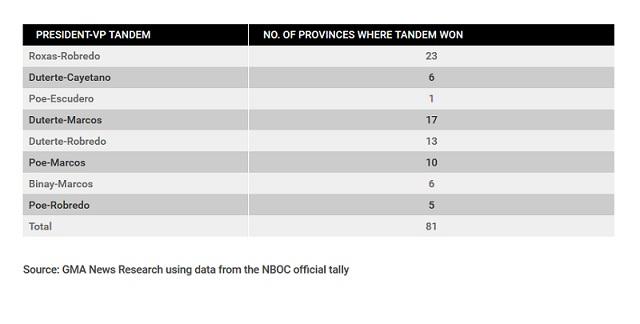
University of the Philippines Political Science Professor Aries Arugay says the dominance of split-ticket voting in the recently concluded elections again underscores the country’s weak political party system and the focus on personalities.
“Sa electoral system natin, you don’t vote for a ticket. Voters vote for individuals, not the ticket. This is a sense of empowerment for the voters to choose kung sino ang gusto nila bilang president or vice president,” Arugay notes. “It shows that the party system is weak, that we vote more on the personality. Hindi beholden ang mga botante sa mga ticket.”
Strongest tandem
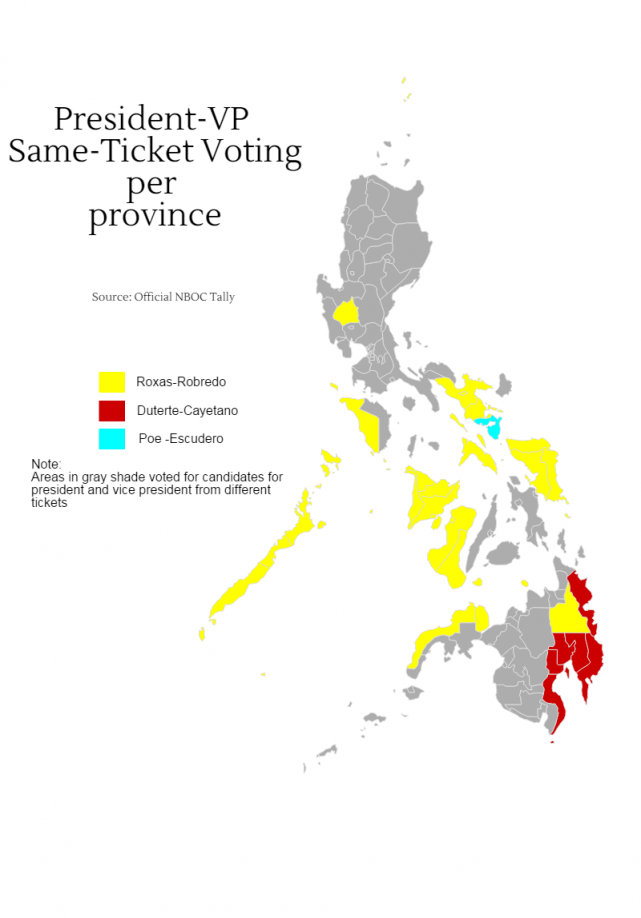
The 30 provinces where same-ticket voting ruled had the following winners for president and vice president:
- Roxas-Robredo in 23 provinces
- Duterte-Cayetano in 6 provinces
- Poe-Escudero in Sorsogon
The tandem of former DILG Secretary Manuel “Mar” Roxas II and Robredo won in 11 out of 16 provinces in the Visayas. They were also the top choice in eight Luzon provinces and in four Mindanao provinces.
Arugay notes that the Roxas-Robredo win in many provinces shows the powerful machinery of the administration Liberal Party at work. He says it was Robredo, a virtual unknown during the start of the election period, who benefited most from LP’s Daang Matuwid campaign.
The tandem of Duterte and Sen. Alan Peter Cayetano won in all five provinces of the Davao Region as well as the province of Surigao del Sur.
The victory of Sen. Grace Poe and running mate Sen. Francis Escudero in Sorsogon is not a surprise, the province being Escudero’s hometown.
The two other president-VP tandems did not top the votes as a single ticket in any province: Vice President Jejomar Binay and Sen. Gringo Honasan of the United Nationalist Alliance and of Sen. Miriam Defensor Santiago and Sen. Ferdinand Marcos Jr.
Split-ticket voting
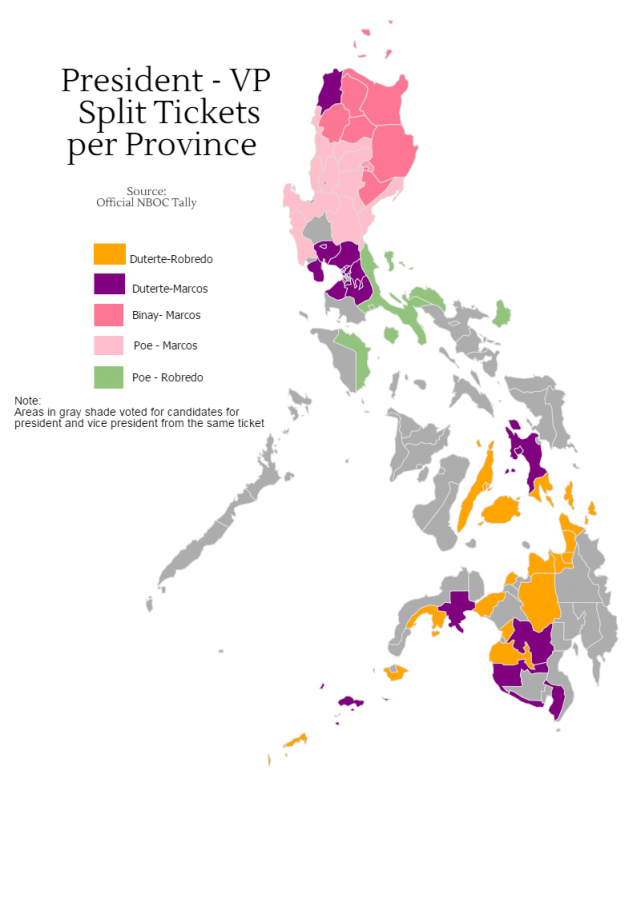
The 51 provinces whose voters split their tickets for president and vice president had the following winners:
- Duterte-Marcos in 17 provinces
- Duterte-Robredo in 13 provinces
- Poe-Marcos in 10 provinces
- Poe-Robredo in 5 provinces
- Binay-Marcos in 6 provinces
In Metro Manila, 16 out of the 17 local government units had Duterte and Marcos as top choices for president and vice president. Binay got the most number of votes for president in his bailiwick of Makati City while Cayetano won as vice president in his hometown of Taguig City.
Arugay says the different permutations indicate that voters are rational in their pairings. He notes that those who voted Duterte-Cayetano are the solid Duterte followers. Duterte-Robredo voters saw that the two may complement each other while Duterte-Marcos voters thought they may supplement each other, Arugay says.
In the same vein, a Mar-Bongbong pairing is “outside the realm of possibility,” he says.
“Kahit na independent ang voting for president at VP, nakitang pinag-isipan. May explanation why such permutations might work. Rational pa rin ang pairing kahit hindi naman sinunod yung ticket,” Arugay says.
Arugay notes that Robredo’s win is an indication of how the congresswoman from Camarines Sur used the LP machinery to her advantage not only by gaining tandem votes but also by showing that she can be a foil to Duterte’s tough stance.
“Leni benefited from the Daang Matuwid campaign. But she cast a wider net when she said she can work with anyone. Dito nakita siya as a possible complementary to Duterte. Nakuha ni Leni ang LP at yung mga ‘soft’ Duterte supporters,” Arugay says.
Duterte-Cayetano
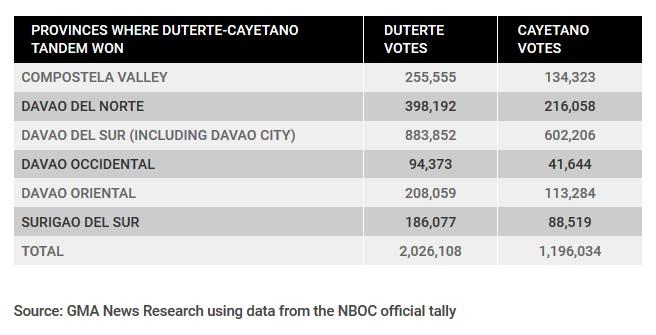
In the recently concluded elections, Duterte’s popularity did not rub off on his running mate Cayetano.
Duterte won in the presidential canvass in 36 out of 81 provinces in the country.
But Cayetano managed to top the vice presidential count in six provinces only, five of which are in Duterte’s bailiwick of Davao Region.
Duterte got more than 2.03 million votes from the provinces where their tandem won. Cayetano got almost 1.2 million votes from these provinces.
The race in vote-rich Metro Manila was one of Duterte’s biggest wins. He was the top choice for president in 16 out of the 17 Metro Manila local government units.
Cayetano, however, ranked third among vice presidential bets in Metro Manila. He won only in his hometown of Taguig City, where he used to be congressman, vice mayor and councilor.
Duterte-Marcos
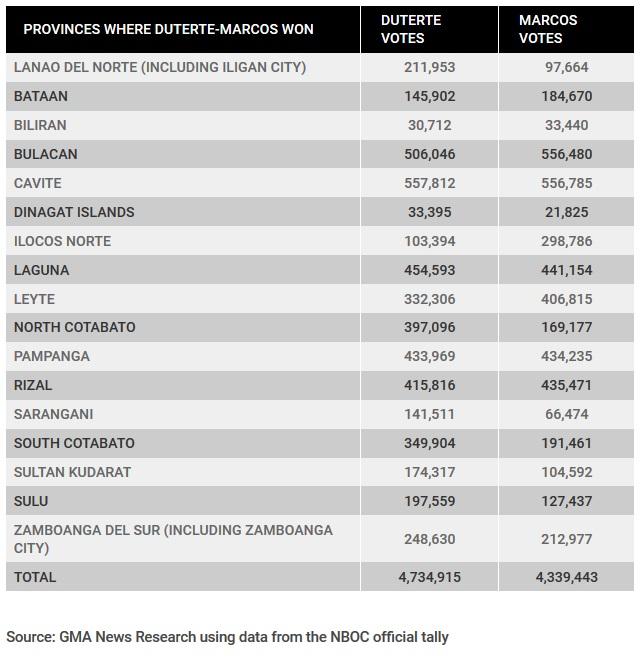
Of the 36 provinces where Duterte won, 17 chose Marcos as vice president instead of Cayetano.
The Duterte-Marcos tandem was the preferred choice in Metro Manila and the vote-rich provinces near the capital including Cavite, Bulacan, Pampanga, Rizal and Laguna.
Duterte and Marcos also got the highest number of votes in all four provinces of Soccsksargen or Region 12.
The tandem also won in Ilocos Norte, Bataan, Leyte, Biliran, Zamboanga del Sur, Lanao del Norte, Dinagat Islands and Sulu.
During his campaign, Duterte had said that the late dictator Ferdinand Marcos, Senator Marcos’s father and namesake, was the best president the country has ever had. He just recently affirmed his campaign declaration that he will allow the remains of Marcos to be buried at the Libingan ng mga Bayani.
Duterte had also noted in his campaign that if he is elected president and fails to
stop criminality in three months, he will resign and give the presidency to Senator Marcos, who was not even his running mate.
Duterte said he has a bond with Bongbong because Duterte’s father, Vicente, was a "close ally of President Marcos until his death". He said his father was a member of the Marcos cabinet as secretary for general services.
In November last year, an Inquirer report quoted Duterte as saying that he had turned down Bongbong’s offer to be his running mate because he has already committed the post to Cayetano. Bongbong, however, clarified that he merely sought the mayor’s endorsement when he thought he was not running for president.
Duterte-Robredo
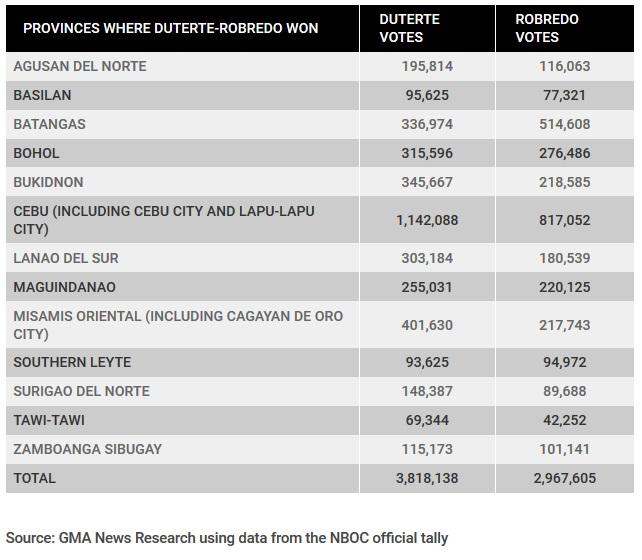
The Duterte-Robredo pairing won in a total of 13 provinces including Cebu, the province with the most number of registered voters. Two other Visayan provinces, Bohol and Southern Leyte, also went for Duterte and Robredo.
Duterte and Robredo also got the most number of votes in nine Mindanao provinces including four of the five provinces in the Autonomous Region in Muslim Mindanao.
Agusan del Norte, Bukidnon, Misamis Oriental, Surigao del Norte and Zamboanga Sibugay voted Duterte-Robredo.
In Luzon, Batangas gave the highest number of votes to Duterte and Robredo.
'RoRo'
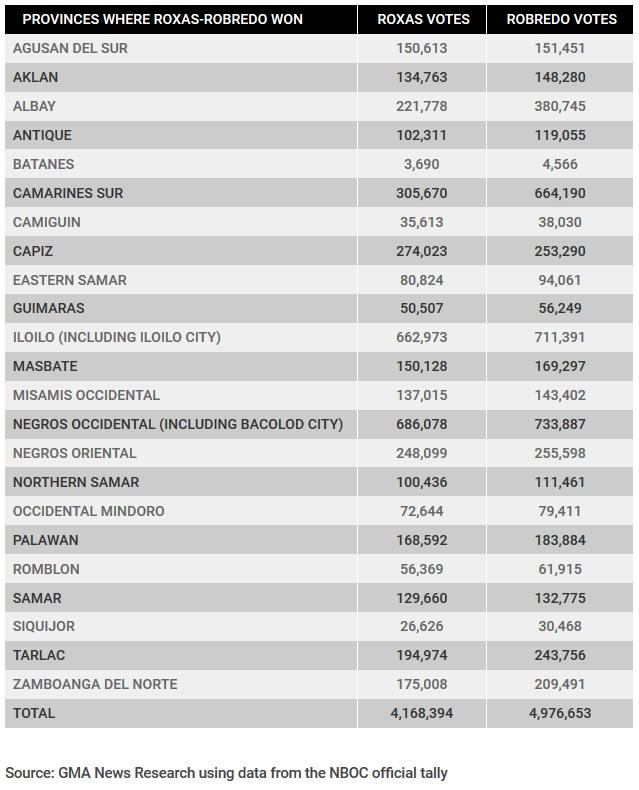
The LP ticket of Roxas and Robredo led in tandem voting in terms of the number of provinces won.
In the 23 provinces where they won the presidential and vice presidential canvass, Robredo got more votes than Roxas. She received 4.98 million votes while Roxas got 4.17 million votes.
The “RoRo” tandem was the top choice in all five provinces of Region 6 or the Western Visayas, where Roxas’ hometown of Capiz belongs. The two provinces of the new Negros Island Region also had Roxas and Robredo as president and vice president.
Half of the six provinces in Region 8 or the Eastern Visayas and the province of Siquijor also went for Roxas and Robredo.
In Mindanao, voters in Zamboanga del Norte, Misamis Occidental, Camiguin and Agusan del Sur gave the most number of votes to Roxas and Robredo.
In Luzon, the LP tandem won in Batanes and President Aquino’s hometown of Tarlac as well as the Region 4B provinces of Occidental Mindoro, Romblon and Palawan.
Region 5 or the Bicol Region did not go all-out RoRo despite Robredo being a daughter of the region. Half of the six Bicol provinces chose Roxas and Robredo—Albay, Masbate and Camarines Sur, where she is Third District representative.
Robredo won in five of the six Bicol provinces. The sixth, Sorsogon, chose Escudero, who hails from the province.
Poe-Robredo
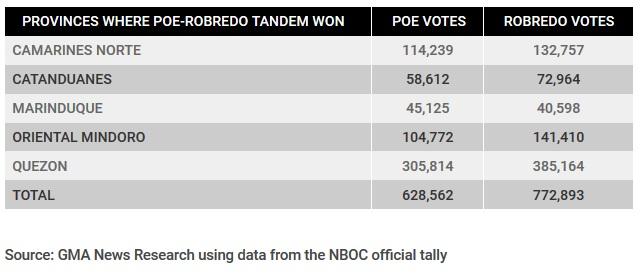
Two Bicol provinces gave the highest number of votes to Poe for president and Robredo for vice president. These are Camarines Norte and Catanduanes.
Also among the five Poe-Robredo provinces were Quezon, Oriental Mindoro and Marinduque.
Poe-Marcos
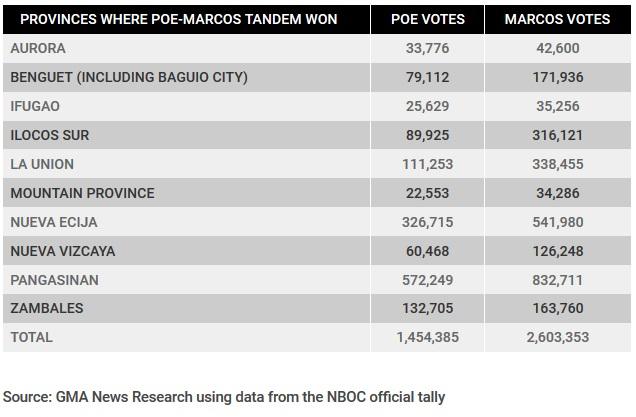
The split ticket of Poe and Marcos won in a total of 10 provinces, all located in Luzon.
These include three of the four Ilocos Region provinces—Pangasinan, La Union and Ilocos Sur—and half of the six Cordillera Administrative Region provinces—Mountain Province, Ifugao and Benguet. Nueva Vizcaya in Region 2 also voted for Poe and Marcos.
The Central Luzon provinces of Nueva Ecija, Zambales and Aurora also went for them.
Binay-Marcos

The other half of the CAR provinces—Abra, Apayao and Kalinga—gave Binay the highest number of votes for president and Marcos for vice president.
The Binay-Marcos split ticket also garnered the biggest votes in three out of five provinces in the Cagayan Valley region. Binay’s mother, Lourdes Gatan Cabauatan, is from Cabagan, Isabela.
The Binay and Marcos tandem ruled in a total of six provinces. —JST, GMA News



